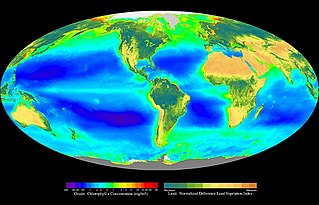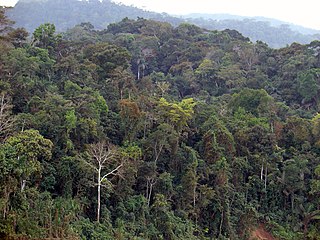Related Research Articles

The biosphere, also known as the ecosphere, is the worldwide sum of all ecosystems. It can also be termed the zone of life on Earth. The biosphere is virtually a closed system with regard to matter, with minimal inputs and outputs. Regarding energy, it is an open system, with photosynthesis capturing solar energy at a rate of around 100 terawatts. By the most general biophysiological definition, the biosphere is the global ecological system integrating all living beings and their relationships, including their interaction with the elements of the lithosphere, cryosphere, hydrosphere, and atmosphere. The biosphere is postulated to have evolved, beginning with a process of biopoiesis or biogenesis, at least some 3.5 billion years ago.

The Holocene extinction, or Anthropocene extinction, is the ongoing extinction event caused by humans during the Holocene epoch. These extinctions span numerous families of plants and animals, including mammals, birds, reptiles, amphibians, fish, and invertebrates, and affecting not just terrestrial species but also large sectors of marine life. With widespread degradation of biodiversity hotspots, such as coral reefs and rainforests, as well as other areas, the vast majority of these extinctions are thought to be undocumented, as the species are undiscovered at the time of their extinction, which goes unrecorded. The current rate of extinction of species is estimated at 100 to 1,000 times higher than natural background extinction rates and is increasing. During the past 100–200 years, biodiversity loss and species extinction have accelerated, to the point that most conservation biologists now believe that human activity has either produced a period of mass extinction, or is on the cusp of doing so. As such, after the "Big Five" mass extinctions, the Holocene extinction event has also been referred to as the sixth mass extinction or sixth extinction; given the recent recognition of the Capitanian mass extinction, the term seventh mass extinction has also been proposed for the Holocene extinction event.
The noosphere is a philosophical concept developed and popularized by the biogeochemist Vladimir Vernadsky, and philosopher and Jesuit priest Pierre Teilhard de Chardin. Vernadsky defined the noosphere as the new state of the biosphere and described as the planetary "sphere of reason". The noosphere represents the highest stage of biospheric development, that of humankind's rational activities.

Biomass is the mass of living biological organisms in a given area or ecosystem at a given time. Biomass can refer to species biomass, which is the mass of one or more species, or to community biomass, which is the mass of all species in the community. It can include microorganisms, plants or animals. The mass can be expressed as the average mass per unit area, or as the total mass in the community.

The Anthropocene is a proposed geological epoch dating from the commencement of significant human impact on Earth's geology, landscape, limnology and ecosystems, including, but not limited to, anthropogenic climate change. The nature of the effects of human activities on Earth can be seen for example in biodiversity loss, climate change, biogeography and nocturnality parameters, changes in geomorphology and stratigraphy.

The natural environment or natural world encompasses all living and non-living things occurring naturally, meaning in this case not artificial. The term is most often applied to Earth or some parts of Earth. This environment encompasses the interaction of all living species, climate, weather and natural resources that affect human survival and economic activity. The concept of the natural environment can be distinguished as components:
The ideosphere—like the noosphere —is the metaphysical 'place' where thoughts, theories, ideas, and ideation are regarded to be created, evaluated, and evolved.

Biogeochemistry is the scientific discipline that involves the study of the chemical, physical, geological, and biological processes and reactions that govern the composition of the natural environment. In particular, biogeochemistry is the study of biogeochemical cycles, the cycles of chemical elements such as carbon and nitrogen, and their interactions with and incorporation into living things transported through earth scale biological systems in space and time. The field focuses on chemical cycles which are either driven by or influence biological activity. Particular emphasis is placed on the study of carbon, nitrogen, oxygen, sulfur, iron, and phosphorus cycles. Biogeochemistry is a systems science closely related to systems ecology.
This glossary of climate change is a list of definitions of terms and concepts relevant to climate change, global warming, and related topics.
Global change in broad sense refers to planetary-scale changes in the Earth system. It is most commonly used to encompass the variety of changes connected to the rapid increase in human activities which started around mid-20th century, i.e., the Great Acceleration. While the concept stems from research on the climate change, it is used to adopt a more holistic view of the observed changes. Global change refers to the changes of the Earth system, treated in its entirety with interacting physicochemical and biological components as well as the impact human societies have on the components and vice versa. Therefore, the changes are studied through means of Earth system science.

The Max Planck Institute for Chemistry is a non-university research institute under the auspices of the Max Planck Society in Mainz, Germany. It was created as the Kaiser Wilhelm Institute for Chemistry in 1911 in Berlin.

The following outline is provided as an overview of and topical guide to Earth science:
Anthropogenic metabolism, also referred to as metabolism of the anthroposphere, is a term used in industrial ecology, material flow analysis, and waste management to describe the material and energy turnover of human society. It emerges from the application of systems thinking to the industrial and other man-made activities and it is a central concept of sustainable development. In modern societies, the bulk of anthropogenic (man-made) material flows is related to one of the following activities: sanitation, transportation, habitation, and communication, which were "of little metabolic significance in prehistoric times". Global man-made stocks of steel in buildings, infrastructure, and vehicles, for example, amount to about 25 Gigatonnes, a figure that is surpassed only by construction materials such as concrete. Sustainable development is closely linked to the design of a sustainable anthropogenic metabolism, which will entail substantial changes in the energy and material turnover of the different human activities. Anthropogenic metabolism can be seen as synonymous to social or socioeconomic metabolism. It comprises both industrial metabolism and urban metabolism.
The Early Anthropocene Hypothesis is a stance concerning the beginning of the Anthropocene first proposed by William Ruddiman in 2003. It posits that the Anthropocene, a proposed geological epoch coinciding with the most recent period in Earth's history when the activities of the human race first began to have a significant global impact on Earth's climate and ecosystems, did not begin during European colonization of the Americas, as numerous scholars posit, nor the eighteenth century with advent of coal-burning factories and power plants of the industrial era, as originally argued by Paul Crutzen, nor in the 1950s as claimed by the Anthropocene Working Group, but dates back to 8,000 years ago, triggered by intense farming activities after agriculture became widespread. It was at that time that atmospheric greenhouse gas concentrations stopped following the periodic pattern of rises and falls that had accurately characterized their past long-term behavior, a pattern that is explained by natural variations in Earth's orbit known as Milankovitch cycles.
Total human ecosystem (THE) is an eco-centric concept initially proposed by ecology professors Zeev Naveh and Arthur S. Lieberman in 1994.

Anthropogenic biomes, also known as anthromes, human biomes or intensive land-use biome, describe the terrestrial biosphere (biomes) in its contemporary, human-altered form using global ecosystem units defined by global patterns of sustained direct human interaction with ecosystems. Anthromes are generally composed of heterogeneous mosaics of different land uses and land covers, including significant areas of fallow or regenerating habitats.

Earth system science (ESS) is the application of systems science to the Earth. In particular, it considers interactions and 'feedbacks', through material and energy fluxes, between the Earth's sub-systems' cycles, processes and "spheres"—atmosphere, hydrosphere, cryosphere, geosphere, pedosphere, lithosphere, biosphere, and even the magnetosphere—as well as the impact of human societies on these components. At its broadest scale, Earth system science brings together researchers across both the natural and social sciences, from fields including ecology, economics, geography, geology, glaciology, meteorology, oceanography, climatology, paleontology, sociology, and space science. Like the broader subject of systems science, Earth system science assumes a holistic view of the dynamic interaction between the Earth's spheres and their many constituent subsystems fluxes and processes, the resulting spatial organization and time evolution of these systems, and their variability, stability and instability. Subsets of Earth System science include systems geology and systems ecology, and many aspects of Earth System science are fundamental to the subjects of physical geography and climate science.
Novel ecosystems are human-built, modified, or engineered niches of the Anthropocene. They exist in places that have been altered in structure and function by human agency. Novel ecosystems are part of the human environment and niche, they lack natural analogs, and they have extended an influence that has converted more than three-quarters of wild Earth. These anthropogenic biomes include technoecosystems that are fuelled by powerful energy sources including ecosystems populated with technodiversity, such as roads and unique combinations of soils called technosols. Vegetation associations on old buildings or along field boundary stone walls in old agricultural landscapes are examples of sites where research into novel ecosystem ecology is developing.
The Anthropocene Working Group (AWG) is an interdisciplinary research group dedicated to the study of the Anthropocene as a geological time unit. It was established in 2009 as part of the Subcommission on Quaternary Stratigraphy (SQS), a constituent body of the International Commission on Stratigraphy (ICS). As of 2021, the research group features 37 members, with the physical geographer Simon Turner as Secretary and the geologist Colin Neil Waters as chair of the group. The late Nobel Prize-winning Paul Crutzen, who popularized the word 'Anthropocene' in 2000, had also been a member of the group until he died on January 28, 2021. The main goal of the AWG is providing scientific evidence robust enough for the Anthropocene to be formally ratified by the International Union of Geological Sciences (IUGS) as an Epoch within the Geologic time scale.

The boron cycle is the biogeochemical cycle of boron through the atmosphere, lithosphere, biosphere, and hydrosphere.
References
- ↑ Kuhn, A.; Heckelei, T. (4 June 2010). "Anthroposphere". In Speth, Peter; Christoph, Michael; Diekkrüger, Bernd (eds.). Impacts of Global Change on the Hydrological Cycle in West and Northwest Africa. pp. 282–341. doi:10.1007/978-3-642-12957-5_8. ISBN 978-3-642-12956-8.
- ↑ Hermann-Pillath, Carsten (2018). "The Case for a New Discipline: Technosphere Science". Ecological Economics. 149: 212–225.
- ↑ Elhacham, Emily; Ben-Uri, Liad; Grozovski, Jonathan; Bar-On, Yinon; Milo, Ron (2020). "Global human-made mass exceeds all living biomass". Nature. doi:10.1038/s41586-020-3010-5.
- ↑ Haff, P. K. (2013-10-24). "Technology as a geological phenomenon: implications for human well-being". Geological Society, London, Special Publications. Geological Society of London. 395 (1): 301–309. doi:10.1144/sp395.4. ISSN 0305-8719.
- ↑ Teilhard de Chardin, Pierre (1964). The Future of Man. London: Collins. p. 157.
- ↑ Zalasiewicz, Jan (2017). "Scale and diversity of the physical technosphere: A geological perspective". The Anthropocene Review. 4 (1): 9–22.